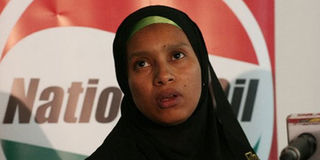Breaking News: Maai Mahiu tragedy: Death toll rises to 45
Kenya shops for oil jetty investor

National Oil Corporation of Kenya (Nock) managing director Sumayya Hassan-Athmani. Photo/FILE
What you need to know:
- Country counts on project to remain dominant oil route for its neighbours
- Kenya has so far, only one main oil jetty, at Kipevu, that off-loads petroleum imports for Kenya, Uganda, Rwanda and Burundi.
Kenya, keen to entrench its strategic role as the hub of the oil trading business in East Africa, will shortly be in the market for an investor to build a massive oil jetty under a private-public partnership arrangement.
The chief executive officer of the National Oil Corporation, Sumayya Athman, told the Nation that most of the preliminary work had been done, setting the stage for an international investor for the facility, estimated to cost between $80 million and $100 million (between Sh6.8 billion and Sh8.5 billion).
Feasibility studies have been concluded and an environmental impact assessment process done, while stakeholder consultations are going on, Ms Athman said.
The oil jetty project is one of the strategic investments Kenya is counting on to help it remain the dominant oil supply route to its landlocked neighbours Uganda, Rwanda, Burundi and eastern Democratic Republic of Congo.
Investor appetite for the facility is predicted to be high, given the rapid growth in demand for petroleum products in East Africa and the inadequate petroleum off-loading and storage facilities at the Mombasa port.
Kenya has so far, only one main oil jetty, at Kipevu, that off-loads petroleum imports for Kenya, Uganda, Rwanda and Burundi.
And, by international standards, this jetty is still limited in capacity as it can only handle ships of up to 85,000 metric tonnes.
It is supported by a smaller jetty at Shimanzi that accommodates much smaller cargo of up to 30,000 metric tonnes.
Imports through this smaller jetty are more expensive by at least $10 to $25 per metric tonne, which explains the long queues of vessels in Mombasa waiting to discharge petroleum.
This story was first published in this week’s The EastAfrican




